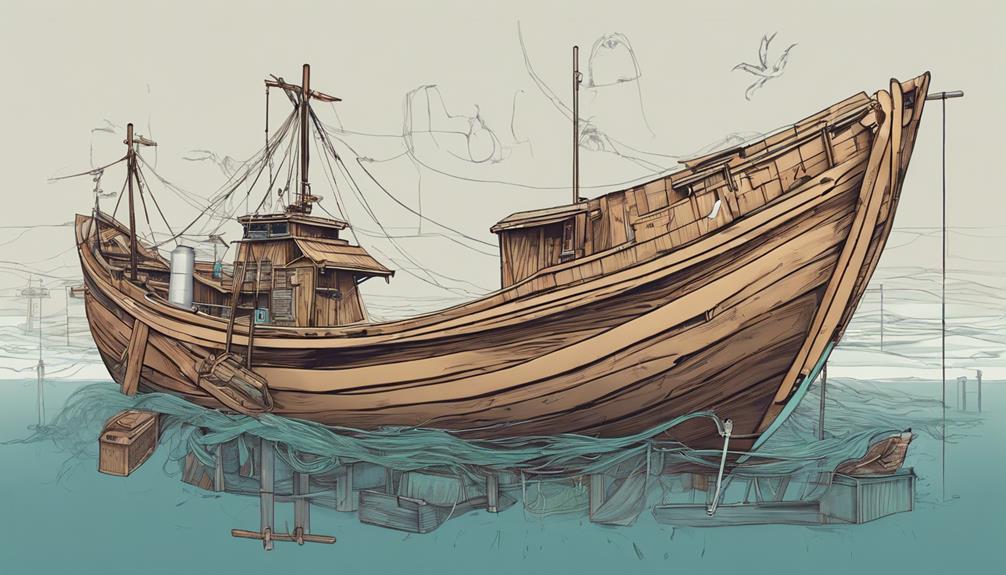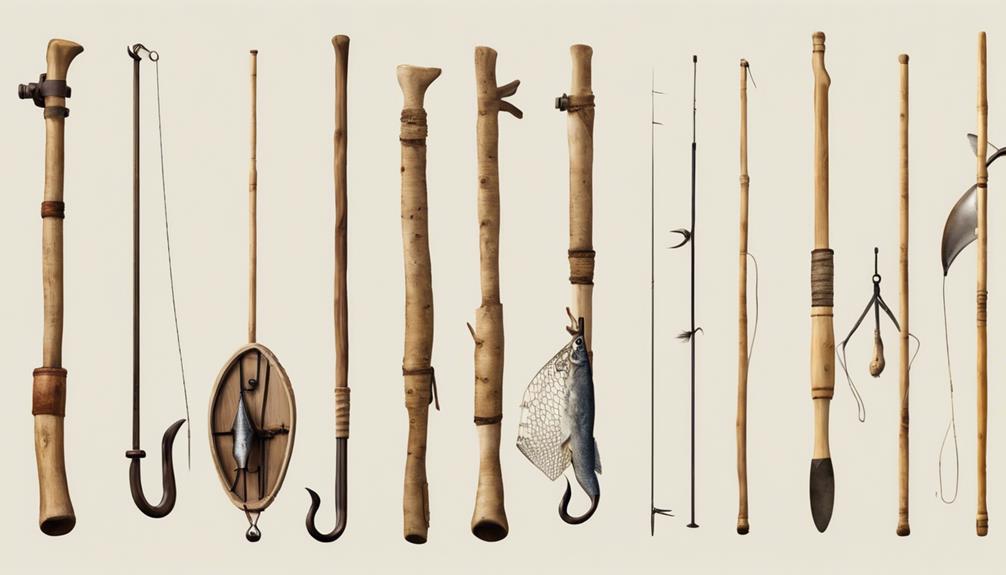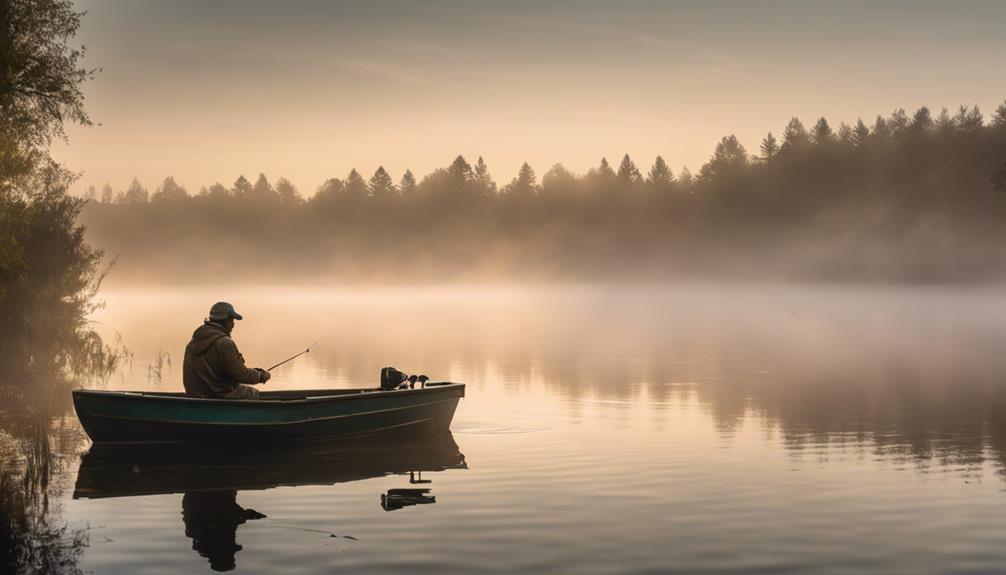Have you ever pondered on the monumental shifts that historical fishing methods have undergone through the ages? From humble beginnings to intricate systems, the evolution of fishing techniques is a tale woven with layers of complexity.
As you navigate through the annals of history, you will uncover a fascinating interplay of factors that propelled these changes, each more intriguing than the last.
Stay tuned to unravel the mysteries behind this captivating transformation that continues to shape the way we interact with the bounties of the sea.
Early Fishing Tools and Techniques
When exploring early fishing tools and techniques, it's fascinating to discover the ingenuity of our ancestors. In ancient times, fishing was a crucial skill for survival, providing communities with a vital food source. Primitive hooks made from bone or wood were one of the earliest tools used for fishing. These simple yet effective hooks allowed early humans to catch fish with greater efficiency. Additionally, nets played a significant role in ancient fishing methods, showcasing the resourcefulness and skill of early fishermen. These nets were crafted from natural materials like plant fibers or animal sinew, demonstrating a deep understanding of the environment and its resources.
The evolution of ancient fishing methods was driven by the constant need to improve efficiency and effectiveness. Over time, our ancestors developed new techniques and tools to enhance their fishing capabilities. The mastery of skills such as spearfishing and using traps further exemplified the adaptability and intelligence of early fishermen. Through trial and error, they honed their methods, learning from each success and failure.
As you delve into the world of early fishing tools and techniques, you can't help but appreciate the ingenuity and perseverance of those who came before us. Their innovative approaches to fishing laid the foundation for the techniques we use today, highlighting the timeless importance of this ancient practice in human history.
Influence of Geographic Factors
Geographic factors significantly shape the evolution of historical fishing methods. The location of a community in proximity to bodies of water plays a crucial role in determining the fishing techniques they develop. Different regions around the world have varying geographic influences that impact the availability of fish and natural resources, thereby influencing the fishing methods employed by local inhabitants.
In areas with abundant marine life, such as coastal regions or near rivers and lakes, communities often rely heavily on fishing as a primary food source. The geographic influences of these locations provide easy access to fish, prompting the development of specialized fishing tools and techniques tailored to the local aquatic environment. For instance, communities located near coral reefs may utilize spearfishing methods due to the clear waters and the abundance of fish species found in such ecosystems.
Conversely, communities situated in arid regions or areas far from water bodies may have limited access to fish. In such geographic settings, historical fishing methods may involve practices such as net fishing in seasonal rivers or the creation of fish ponds to cultivate and harvest fish. These adaptations showcase how geographic factors directly impact the evolution of fishing methods based on the availability of natural resources in different environments.
Technological Advancements in Fishing
Advancing technology has revolutionized fishing practices worldwide, enhancing efficiency and sustainability in the industry. Automation in fishing has significantly improved the way fishing operations are conducted. Automated systems can help with tasks such as baiting hooks, setting lines, and even reeling in catches, reducing the manual labor required and increasing overall productivity.
Improved fishing gear has also played a crucial role in modernizing the fishing industry. Innovations in materials and design have led to the development of stronger, more durable equipment that can withstand harsh marine environments and target specific species with greater precision. These advancements haven't only made fishing more efficient but have also reduced the impact on marine ecosystems by minimizing bycatch and unintentional harm to non-targeted species.
Digital fishing tools have become essential for modern fishermen. Technologies such as fish finders, GPS navigation systems, and underwater cameras allow fishermen to locate schools of fish more accurately, increasing catch rates while decreasing fuel consumption. Remote fishing methods, such as the use of unmanned underwater vehicles (UUVs) and drones, enable fishermen to explore deeper waters and monitor fishing grounds from afar, further optimizing their operations.
Impact of Cultural Traditions
As fishing practices evolve with technological advancements, the impact of cultural traditions on the industry becomes increasingly significant. Cultural influences play a crucial role in shaping fishing methods and techniques. Tradition is often deeply ingrained in communities dependent on fishing, leading to the adaptation of practices over time.
Cultural influences can be seen in various aspects of fishing, such as the types of gear used, the methods employed, and even the rituals surrounding fishing activities. For example, in some cultures, certain fishing techniques have been passed down through generations, preserving traditional knowledge and skills. This preservation of tradition contributes to the evolution of fishing practices as communities find ways to blend old customs with new technologies.
The evolution of fishing methods isn't solely driven by technological advancements but is also heavily influenced by cultural traditions. Communities around the world continue to practice fishing in ways that reflect their heritage and values. As a result, the fishing industry is a rich tapestry of traditions and adaptations that have been shaped by centuries of cultural influence.
Evolution of Bait and Lure Strategies
Traditional fishing communities have long relied on innovative bait and lure strategies to enhance their catch. Over time, these strategies have evolved from simple and traditional methods to more sophisticated techniques that take advantage of modern technology and scientific knowledge.
Let's explore some key aspects of the evolution of bait and lure strategies:
- Traditional vs modern lures: In the past, fishermen used natural bait such as worms, insects, or small fish to attract their target species. Nowadays, modern lures come in a wide range of shapes, sizes, and colors, designed to mimic the movement and appearance of various prey species. These artificial lures can be more efficient and versatile than traditional bait, offering anglers a greater chance of success.
- Historical bait innovations: Throughout history, fishermen have developed various bait innovations to improve their fishing results. From the use of scent-based baits to attract fish from a distance to the creation of artificial flies for fly fishing, the evolution of bait techniques has been driven by the desire to outsmart fish and increase catch rates.
Changes in Fishing Vessels
The evolution of bait and lure strategies has influenced the design and functionality of fishing vessels throughout history. Vessel design has continuously adapted to improve efficiency in catching fish. In the past, fishing boats were often simple, small crafts used for basic fishing tasks. However, with the rise of maritime trade and development, fishing vessels evolved into larger, more specialized ships capable of traveling longer distances and carrying larger catches.
Efficiency became a key factor in vessel design as fishermen sought to increase their productivity. This led to the development of features such as larger storage capacities, improved stability in rough waters, and specialized equipment like winches and cranes for handling heavy nets. These advancements allowed fishermen to expand their operations and venture into deeper waters where more abundant fish populations could be found.
Moreover, the connection between maritime trade and fishing vessel design became apparent as fishermen needed vessels that couldn't only catch fish but also transport them to markets efficiently. This demand spurred innovations in refrigeration systems on board, enabling fishermen to preserve their catches for longer periods and reach more distant markets.
Role of Environmental Conservation

Environmental conservation plays a crucial role in shaping the future of fishing practices and sustainability. As a responsible fisher, it's essential to consider the impact of your actions on the marine ecosystem and strive to adopt sustainable practices. Here are some key points to keep in mind:
- Preservation of Marine Ecosystem: By practicing sustainable fishing methods, you contribute to the preservation of the delicate balance within the marine ecosystem. Overfishing and destructive techniques can lead to imbalances that may have far-reaching consequences on marine life and habitats.
- Promotion of Biodiversity: Sustainable fishing practices help maintain biodiversity by allowing fish populations to thrive and reproduce naturally. This, in turn, supports the overall health of the marine ecosystem and ensures the continuity of various species for future generations.
- Reduction of Bycatch: Implementing techniques that minimize bycatch – the unintentional capture of non-target species – is crucial for environmental conservation. By reducing bycatch, you help protect vulnerable species and maintain the ecological diversity of the oceans.
- Long-Term Sustainability: Embracing sustainable fishing practices isn't just about the present; it's about securing the future of fishing for generations to come. By acting responsibly now, you contribute to the long-term sustainability of fish stocks and the health of the marine environment.
Modernization of Fishing Practices
With advancements in technology and techniques, fishing practices have undergone significant modernization in recent years. These changes have been crucial in promoting sustainable fishing and ensuring the protection of marine ecosystems. Fishing regulations play a fundamental role in modernizing fishing practices by setting guidelines and limits to prevent overfishing and preserve fish populations for future generations.
One aspect of modernization is the implementation of sustainable fishing practices. This includes using methods that minimize bycatch, protect endangered species, and promote the long-term health of fish stocks. Technologies such as GPS tracking and fish aggregating devices help fishermen target specific species while avoiding overfished areas. By adopting these sustainable practices, fishermen can contribute to maintaining a balanced marine ecosystem and securing their livelihoods for years to come.
Moreover, fishing regulations serve as a framework for modern fishing practices. These regulations establish catch limits, fishing seasons, and gear restrictions to prevent the depletion of fish populations. By enforcing these rules, authorities can monitor and manage fishing activities effectively. Compliance with fishing regulations is essential for the success of modernization efforts, as it ensures that fishing practices remain sustainable and environmentally responsible.
Frequently Asked Questions
How Did Fishing Methods Vary Between Different Ancient Civilizations?
Fishing methods varied between ancient civilizations due to technological advancements and cultural influences.
Each civilization developed unique techniques suited to their environment and resources. Some used simple tools like spears or nets, while others employed more sophisticated methods such as traps or weirs.
The availability of materials, knowledge passed down through generations, and the specific needs of each society all played a role in shaping their fishing practices.
What Role Did Superstitions and Beliefs Play in Shaping Historical Fishing Practices?
Superstitions and beliefs held significant sway over historical fishing practices. Cultural influences, like rituals to ensure bountiful catches, intertwined with societal norms to shape how communities approached fishing.
Technological advancements also played a role, adapting methods to the environment and available resources. These factors combined to create a rich tapestry of fishing traditions that evolved over time, reflecting the complex interplay between human beliefs, superstitions, and practical innovations.
Were There Any Notable Conflicts or Disputes Related to Fishing Rights in the Past?
Territorial disputes and international conflicts have long been intertwined with historical fishing rights. Resource management and conservation efforts often sparked notable conflicts in the past. These disputes shaped fishing practices and regulations, reflecting the struggle to balance economic interests with environmental sustainability.
Over time, evolving fishing methods were influenced by the need to address these conflicts and find solutions that would benefit both fishermen and the marine ecosystem.
How Did the Introduction of Foreign Fishing Techniques Impact Local Communities?
When foreign fishing techniques were introduced, local communities experienced a significant shift. Cultural exchange brought new methods, altering traditional practices.
The economic impact was profound, with increased efficiency and productivity in some cases, but also competition and displacement for others. Communities had to adapt to these changes, leading to a nuanced relationship between innovation and preservation of heritage.
What Was the Role of Women in Traditional Fishing Practices Throughout History?
In traditional fishing practices throughout history, women's contributions were essential. They played vital roles in tasks like preparing nets, gathering bait, and processing the catch. These roles were often deeply ingrained in cultural traditions, passing down knowledge and skills from generation to generation.
Women's involvement helped sustain fishing communities and ensure the success of fishing ventures. Their expertise and hard work were crucial for the community's survival and prosperity.
Conclusion
You have seen how historical fishing methods evolved over time due to various factors such as geographic influences, technological advancements, cultural traditions, and environmental conservation efforts.
From early tools and techniques to modern practices, the fishing industry has adapted and changed to meet the demands of the times.
By understanding the reasons behind these changes, we can appreciate the importance of evolution in maintaining sustainable fishing practices for future generations.



